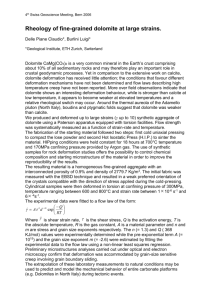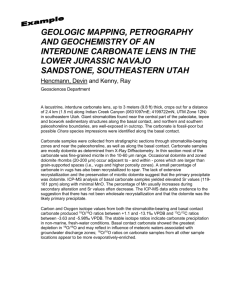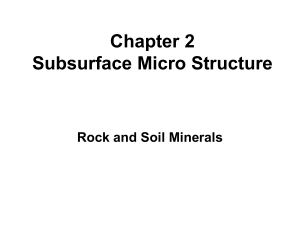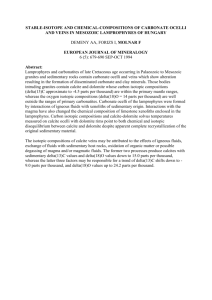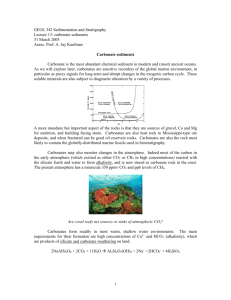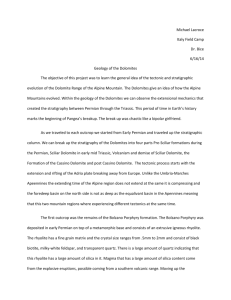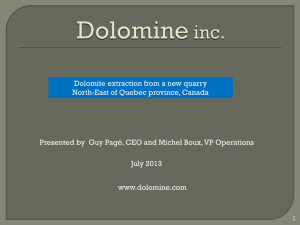grl53733-sup-0001-supinfo
advertisement
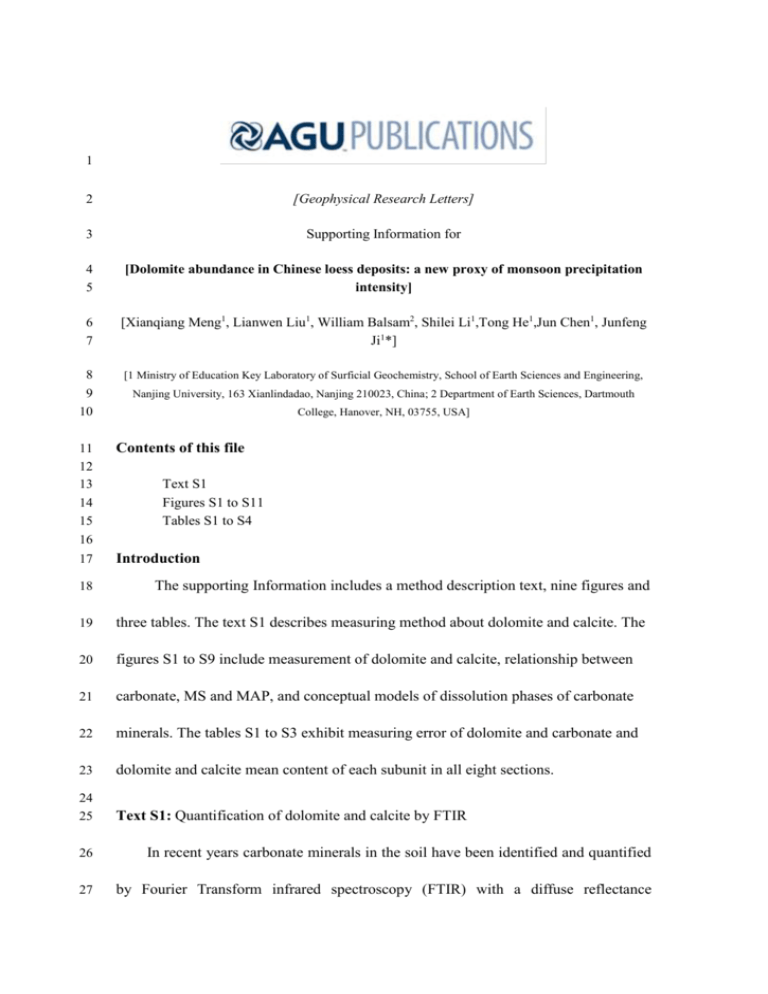
1 2 [Geophysical Research Letters] 3 Supporting Information for 4 5 [Dolomite abundance in Chinese loess deposits: a new proxy of monsoon precipitation intensity] 6 7 [Xianqiang Meng1, Lianwen Liu1, William Balsam2, Shilei Li1,Tong He1,Jun Chen1, Junfeng Ji1*] 8 9 10 [1 Ministry of Education Key Laboratory of Surficial Geochemistry, School of Earth Sciences and Engineering, Nanjing University, 163 Xianlindadao, Nanjing 210023, China; 2 Department of Earth Sciences, Dartmouth College, Hanover, NH, 03755, USA] 11 12 13 14 15 16 Contents of this file 17 Introduction 18 Text S1 Figures S1 to S11 Tables S1 to S4 The supporting Information includes a method description text, nine figures and 19 three tables. The text S1 describes measuring method about dolomite and calcite. The 20 figures S1 to S9 include measurement of dolomite and calcite, relationship between 21 carbonate, MS and MAP, and conceptual models of dissolution phases of carbonate 22 minerals. The tables S1 to S3 exhibit measuring error of dolomite and carbonate and 23 dolomite and calcite mean content of each subunit in all eight sections. 24 25 Text S1: Quantification of dolomite and calcite by FTIR 26 In recent years carbonate minerals in the soil have been identified and quantified 27 by Fourier Transform infrared spectroscopy (FTIR) with a diffuse reflectance 28 attachment, which is a quick and relatively inexpensive method that is sensitive to 29 carbonate molecular vibration signal [Álvarez et al., 2012; He et al., 2012; Ji et al., 30 2009; Legodi et al., 2001; Nguyen et al., 1991; Reeves Iii, 2010; Reig et al., 2002; 31 Tatzber et al., 2007]. We selected the absorption peaks from 2513-2522 cm-1 (for total 32 carbonate) and 2626 cm-1 (for dolomite) because they are free of interference from 33 other minerals in a non-carbonate soil matrix and the reflection peaks area is far 34 greater than other peaks (Figure S2). Because the peak 2626 cm-1 is easy to hide by 35 high calcite content, the calcite was completely removed from bulk sample by weak 36 acid. A series of condition experiments (Table S2) were designed to find a best 37 reaction condition under which calcite was removed completely and dolomite 38 remained unattacked. First, 0.5 g of sample was placed into a 50 ml centrifuge tube 39 with 45ml of 0.05, 0.1, 0.2 and 0.5 mole/L acetic acid when the total carbonate 40 content of bulk sample was about ≤ 8% (relative error (δ )= ± 24.43%),8 - 14% (δ = ± 41 8.65%), 14 - 18% (δ = ± 7.45%) and ≥18% (δ = ± 10.51%) respectively (Table DR2), 42 and reacted for 30 minutes at room temperature based on a series of experiments. 43 Then, after the reaction each sample was centrifuged and washed once with deionized 44 water and dried for 24 hours at 45℃, and was determined by FTIR again. The 45 calibration equation of dolomite and total carbonate produced by add them to matrix 46 which removed carbonate completely using hydrochloric acid [Ji et al., 2009]. The 47 quantitative equations are y = 0.000972 x + 0.00217 (R2 = 0.996, RMSE = 0.13) for 48 dolomite and y = 0.0000996 x – 0.00261 (R2 = 0.995, RMSE = 0.72) for total 49 carbonate, where y and x are dolomite or total carbonate content and band area at 50 2626 or 2513 cm-1 respectively (Fig. S 2). Calcite content was obtained by subtracting 51 dolomite from total carbonate. We estimated the limit of detection in our loess matrix 52 was ≤ 0.22% for dolomite and was ≤ 0.13% for total carbonate because the 53 reflectance band area of 0.22% dolomite and 0.13% total carbonate were clear at 2626 54 cm-1 and 2513 cm-1 respectively (Figure S4). 55 Dolomite and protodolomite are also appear in soil. Protodolomite is defined as 56 those metastable single-phase rhombohedral carbonates which are imperfectly ordered. 57 Previous studies using XRD and SEM methods demonstrated that dolomite in 58 Chinese loess is composed of well-ordered crystals with d104 = 2.886 and a detrital 59 morphology under the SEM, whereas the protodolomite has a d104 value of about 60 2.902 (Fig. S5), is of pedogenic origin, has a low Mg/Ca (<0.6), and is only found in 61 the underlying late Neogene Red Clay [He et al., 2012; Li et al., 2007]. 62 63 Additional references in supporting information “text S1” 64 Álvarez, J. L. G., M. J. T. Martínez, and M. A. Fernández (2012), Development of a 65 method for the quantitative analysis of urinary stones, formed by a mixture of 66 two components, using infrared spectroscopy, Clinical biochemistry, 45(7), 67 582-587, doi: 10.1016/j.clinbiochem.2012.02.008. 68 He, T., Y. Chen, W. Balsam, X. Sheng, L. Liu, J. Chen, and J. Ji (2012), Distribution 69 and origin of protodolomite from the late Miocene-Pliocene Red Clay Formation, 70 Chinese Loess Plateau, Geochemistry Geophysics Geosystems, 13, 1-17, doi: 71 10.1029/2012gc004039. 72 Ji, J., Y. Ge, W. Balsam, J. E. Damuth, and J. Chen (2009), Rapid identification of 73 dolomite using a Fourier Transform Infrared Spectrophotometer (FTIR): A fast 74 method for identifying Heinrich events in IODP Site U1308, Marine Geology, 75 258(1-4), 60-68, doi: 10.1016/j.margeo.2008.11.007. 76 Legodi, M., D. de Waal, J. Potgieter, and S. Potgieter (2001), Rapid determination of 77 CaCO< sub> 3</sub> in mixtures utilising FT—IR spectroscopy, Minerals 78 engineering, 14(9), 1107-1111, doi: 10.1016/S0892-6875(01)00116-9. 79 Li, G., J. Chen, Y. Chen, J. Yang, J. Ji, and L. Liu (2007), Dolomite as a tracer for the 80 source regions of Asian dust, Journal of Geophysical Research, 112(D17), 1-7, 81 doi: 10.1029/2007jd008676. 82 Nguyen, T., L. J. Janik, and M. Raupach (1991), Diffuse reflectance infrared Fourier 83 transform (DRIFT) spectroscopy in soil studies, Soil Research, 29(1), 49-67, doi: 84 10.1071/SR9910049 85 Porter, S. C., B. Hallet, X. Wu, and Z. An (2001), Dependence of Near-Surface 86 Magnetic Susceptibility on Dust Accumulation Rate and Precipitation on the 87 Chinese 88 10.1006/qres.2001.2224. Loess Plateau, Quaternary Research, 55(3), 271-283, doi: 89 Reeves Iii, J. B. (2010), Near- versus mid-infrared diffuse reflectance spectroscopy 90 for soil analysis emphasizing carbon and laboratory versus on-site analysis: 91 Where are we and what needs to be done?, Geoderma, 158(1–2), 3-14, doi: 92 org/10.1016/j.geoderma.2009.04.005. 93 Reig, F. B., J. Adelantado, and M. Moya Moreno (2002), FTIR quantitative analysis 94 of calcium carbonate (calcite) and silica (quartz) mixtures using the constant 95 ratio method. Application to geological samples, Talanta, 58(4), 811-821. 96 Tatzber, M., M. Stemmer, H. Spiegel, C. Katzlberger, G. Haberhauer, and M. 97 Gerzabek (2007), An alternative method to measure carbonate in soils by FT-IR 98 spectroscopy, 99 10.1007/s10311-006-0079-5. 100 Environmental Chemistry Letters, 5(1), 9-12, doi: 101 Figures S1 to S10 102 103 104 Figure S1. FTIR spectra of the bulk, HAOc- and HCl- treated loess sample (PL-115, 105 L1) and standard dolomite and calcite. Note that the shaded band shows the 106 absorption features at 2626 cm−1, which was used as a proxy for dolomite content. 107 108 109 110 Figure S2. Calibration equation of dolomite (a) and total carbonate contents (b) as a 111 function of reflectance band area at 2626 cm-1 and 2513 cm-1, respectively. Two 112 equations have a high R2 and low RMSE. 113 114 115 116 Figure S3. FTIR spectra of dolomite and total carbonate spiked samples, showing the 117 discrimination of the diagnostic FTIR absorption features of dolomite at 2626 cm-1 (a) 118 and total carbonate at 2513 cm-1 (b). Calcite represents total carbonate because calcite 119 is main carbonate minerals in Chinese loess and the area at 2513 cm-1 by adding 120 calcite is same as dolomite. Pure dolomite and calcite were added to splits of a non 121 carbonate sample to produce samples that contained different weight concentration of 122 dolomite and total carbonate. 123 124 125 Figure S4. Dolomite content change with longitude from west -east transects (a) and 126 latitude from north – south transects (b) in L1 and S1 units of the eight loess sections. 127 128 129 130 Figure S5. X-Ray diffraction patterns of dolomite in four loess-paleosol sections (HX, 131 XF, LC and CX) and showing that dolomite in loess is only detrital origin, not 132 pedogenic protodolomite. For main units and sub-units sample (S0, L1LL1, L1SS1, 133 L1LL2 and S1) are listed. 134 135 136 137 138 Figure S6. The grain size distribution of dolomite and calcite in typical L1 loess samples from CX and HX sections. 139 140 Figure S7. The correlation between dolomite content and MS in the eight sections 141 studied. The low MS values correspond to high dolomite content and vice versa. Low 142 MS on the CLP has also been shown to correspond to low rainfall [Porter et al., 143 2001]. 144 145 146 147 148 Figure S8. Conceptual models concerning four dissolution phases of carbonate 149 minerals. The number 1, 2, 3 and 4 stand for the four dissolution phases of carbonate 150 minerals, respectively. 151 152 153 Figure S9. The four dissolution phases of carbonate minerals in the eight sections 154 from east to west (a) and from south to north (b). The dissolution phase in MIS 5c and 155 d can both be Phase 3 or 4, thus we labeled them as Phase 3 or 4 using dash lines and 156 question mark. The precipitation in MIS 5e is the strongest in all of MIS 5, thus the 157 MIS 5e at LT and BJ sections belong to phase 4 158 159 160 Figure S10. Relation of magnetic susceptibility and calcite content in 161 dolomite-contained samples (dissolution phase 1) (a) and non-dolomite samples 162 (dissolution phase 2) in eight sections. 163 164 165 Figure S11. Variations of dolomite (solid blue line) and calcite (solid red line) during 166 Holocene (S0) in the CR section (MAP=600 mm). SI: 10-8m3kg-1. 167 168 Tables S1 to S3 169 Table S1: Measuring error of instrument XF-100 XF-200 Samples Total carbonate content 1 8.72% 18.23% 2 7.93% 18.27% 3 8.52% 17.11% 4 8.80% 17.14% 5 8.52% 17.19% 6 8.89% 17.37% 7 8.48% 17.86% Mean content 8.41% 17.41% Standard deviation 0.13% 0.31% Relative error (δ) ±1.55% ±1.78% Measuring times 170 171 Table S2: The measuring and methodical error of dolomite quantification XF-90 LC-660 XF-125 XF-200 Samples Dolomite content Concentration of acetic 0.05 0.1 0.2 0.5 30 30 30 30 1 0.56% 1.30% 1.30% 1.88% 2 0.54% 1.19% 1.18% 1.95% 3 0.44% 1.34% 1.22% 1.96% 4 0.41% 1.22% 1.12% 1.83% 5 0.51% 1.22% 1.25% 1.63% 6 0.46% 1.22% 1.25% 1.61% 7 0.50% 1.36% 1.15% 1.68% Mean content 0.49% 1.26% 1.21% 1.79% Standard deviation 0.28% 0.31% 0.29% 0.38% Relative error (δ) ±24.43% ±8.65% ±7.45% ±10.51% acid (mole/L) Reaction time (minutes) Measuring times 172 173 174 Table S3: Mean dolomite and calcite contents in the eight sections Samples Mean Dolomite Mean Calcite Sections Mean value of Units or Subunits NO. content content MS(10–8m3kg–1) LLL1(MIS2) 73 2.78% 16.67% 30.88 LSS1(MIS3) 69 2.43% 16.23% 30.03 LLL2(MIS4) 67 3.20% 16.13% 29.51 S1(MIS5) 68 1.95% 13.23% 33.10 Total 277 2.59% 15.59% 30.88 LLL1(MIS2) 21 1.35% 14.90% 50.32 LSS1(MIS3) 21 1.02% 12.24% 72.13 LLL2(MIS4) 15 1.43% 16.09% 40.40 S1(MIS5) 17 0.28% 7.17% 138.70 Total 74 1.01% 12.54% 75.39 LLL1(MIS2) 20 1.27% 15.77% 55.81 LSS1(MIS3) 22 0.92% 12.51% 80.95 LLL2(MIS4) 24 1.29% 14.61% 44.41 S1(MIS5) 36 0.08% 3.29% 139.86 Total 102 0.73% 9.90% 80.26 LLL1(MIS2) 22 0.83% 13.90% 78.16 Luochuan LSS1(MIS3) 28 0.52% 12.48% 115.87 (LC) LLL2(MIS4) 20 0.88% 13.64% 66.10 S1(MIS5) 21 0.00% 1.91% 209.30 Caoxian (CX) Pingliang (PL) Xifeng (XF) Total 91 0.49% 10.28% 117.36 LLL1(MIS2) 22 1.90% 13.74% 35.67 LSS1(MIS3) 32 1.75% 12.43% 42.52 LLL2(MIS4) 29 2.17% 12.70% 33.35 S1(MIS5) 36 0.59% 11.09% 81.73 Total 119 1.49% 12.61% 48.32 LLL1(MIS2) 25 1.40% 16.43% 56.98 LSS1(MIS3) 43 1.11% 12.23% 87.74 LLL2(MIS4) 34 1.48% 17.62% 44.12 S1(MIS5) 26 0.00% 3.03% 178.86 Total 128 0.98% 12.09% 91.93 LLL1(MIS2) 15 0.38% 5.84% 93.40 LSS1(MIS3) 14 0.36% 4.94% 118.92 Lingtai LLL2(MIS4) 10 0.77% 9.50% 91.56 (LT) S1(MIS5) 23 0.00% 0.32% 174.34 Total 62 0.24% 3.70% 119.56 LLL1(MIS2) 14 0.53% 14.79% 117.32 LSS1(MIS3) 21 0.00% 3.77% 177.50 LLL2(MIS4) 12 0.38% 10.11% 150.21 S1(MIS5) 15 0.00% 0.10% 238.96 Total 62 0.16% 5.62% 171.00 Huanxian (HX) Zhenyuan (ZY) Baoji (BJ) 175 176 177 Table S4: Estimated the input dolomite concentration in glacial-interglacial cycle 178 from the mean grain size distribution data of L1 and S1 samples in western CX 179 section and eastern LC section. We assumed that the dolomite content of each grain 180 size in initial dust input is similar to that of CX-L1 (<30μm, 2.8%wt; 30-45μm, 181 5.2%wt; >45μm, 3.8%wt). Dolomite contents were calculated depended on dolomite 182 content in initial dust and mean percentage of grain size (<30, 30-45 and >45μm) in 183 western CX section and eastern LC section. CX section Dolomite content in assumed initial dust (CX-L1) Percen tage of grain size Dolom ite conten t Percen tage of grain size Dolom ite conten t Percen tage of grain size Dolom ite conten t Percen tage of grain size Dolom ite conten t <30μm 2.80% 60% 1.65% 75% 2.07% 70% 1.93% 79% 2.18% 30-45μm 5.20% 22% 1.16% 15% 0.79% 15% 0.79% 11% 0.58% >45μm 3.80% 18% 0.68% 10% 0.38% 15% 0.57% 10% 0.38% 100% 3.50% 100% 3.24% 100% 3.29% 100% 3.14% Grain size ranges Total 184 L1 LC section S1 L1 S1
